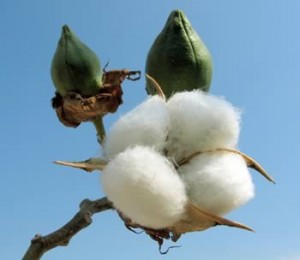Of all the materials out there, organic cotton has to be one of my favorites. On laundry day, in a sea of freshly laundered t-shirts, without even looking, I know exactly when I’ve pulled out my favorite organic cotton Quicksilver t-shirt to be folded—there’s that much difference in softness! But besides the super soft texture, many companies and manufacturers are adding and increasing organic cotton options to their existing lines. In some cases, new companies are emerging altogether because of this trend that’s here to stay.
 So, what’s with organic cotton anyway? What makes it so special and oh so soft?
So, what’s with organic cotton anyway? What makes it so special and oh so soft?
Organic cotton is the version of its conventional counterpart grown without pesticides, herbicides, insecticides, chemical fertilizers or any other chemicals, making it an ideal textile for baby and children’s products. Conventional cotton is one of the most chemically-dependent crops, sucking up 10 percent of all agricultural chemicals and 25 percent of insecticides on 3 percent of our arable land; that’s more than any other crop per unit. That adds up to 1/3 of a pound of chemicals to produce enough cotton for a t-shirt, and 3/4 of a pound for a pair of jeans. Organic cotton on the other hand, uses agricultural methods designed to help sustain the land it grows on, the people who grow and harvest it, and the planet in general. (via Treehugger)
Once again, like with other greener alternatives, organic cotton products tend to cost a bit more—for now. As the demand for organic cotton products continue to increase–and organic products in general–prices will begin to balance out. In 2006, organic fiber linens and clothing sales in the United States grew by 26 percent over the previous year, to reach $203 million, according to the Organic Trade Association’s 2007 Manufacturer Survey.
Because of its healthier composition and sustainable aspects, organic cotton is a great option for baby and kids’ products. It certainly helps that organic cotton goodies are super soft and always hard to pass up.
To read more about organic cotton and its benefits check out these resources
Gaim on organic cotton
Cleaner cotton
The difference of organic cotton
The case for organic cotton
Organic cotton fact sheet
Tag: research
Study sheds light on bath products
There’s a new report out that reveals some daunting information that will make you want to think twice about your babe’s bath products. Oh no, what now, right?
 The Campaign for Safe Cosmetics published a report that says several children’s bath products are contaminated with the cancer-causing chemicals formaldehyde and 1,4-dioxane. This isn’t the first time you’ve probably heard similar information; a study came out in 2008 that focused on organic personal products. However, this new study called, “No More Toxic Tub,” is the first to document the widespread presence of both formaldehyde and 1,4-dioxane in bath products for children, including baby shampoos, bubble baths and baby lotions. The group says Formaldehyde and 1,4-dioxane are known carcinogens; formaldehyde can also trigger skin rashes in some children. The report said that unlike many other countries, the U.S. government does not limit formaldehyde, 1,4-dioxane, or most other hazardous substances in personal care products.
The Campaign for Safe Cosmetics published a report that says several children’s bath products are contaminated with the cancer-causing chemicals formaldehyde and 1,4-dioxane. This isn’t the first time you’ve probably heard similar information; a study came out in 2008 that focused on organic personal products. However, this new study called, “No More Toxic Tub,” is the first to document the widespread presence of both formaldehyde and 1,4-dioxane in bath products for children, including baby shampoos, bubble baths and baby lotions. The group says Formaldehyde and 1,4-dioxane are known carcinogens; formaldehyde can also trigger skin rashes in some children. The report said that unlike many other countries, the U.S. government does not limit formaldehyde, 1,4-dioxane, or most other hazardous substances in personal care products.
Just a few of the products tested are:
- CVS Baby Shampoo (CVS/Pharmacy)
- Suave Kids 2-in-1 Shampoo – Wild Watermelon (Unilever)
- American Girl Real Beauty Inside and Out Shower Gel – Apple Blossom (Bath & Body Works)
- Equate Tearless Baby Wash (Wal-Mart Stores, Inc.)
- Grins & Giggles Milk & Honey Baby Wash (Gerber Products Company)
- Huggies Naturally Refreshing Cucumber & Green Tea Baby Wash (Kimberly-Clark)
- Sesame Street Bubble Bath – Orange Mango Tango (The Village Company)
To see all of the products tested and results go here. Per usual, there’s no need to be alarmed, so don’t go and toss out all of your bath products. The big picture here is, it’s all about being smarter consumers and to be aware of what you’re buying and using. I mean, who doesn’t want the best for their kid?
Once again, I’ll take the opportunity to tout the awesomeness of natural products. With this latest report, I thought I’d share some alternatives to the more questionable products that were included in this latest study.
These are my top picks:
